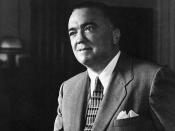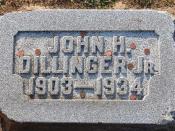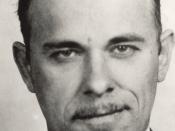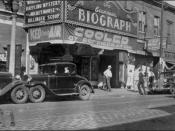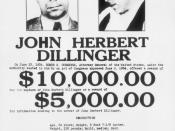The 1930's An Age of Depression The Great Depression was started on October 24th also known as "Black Thursday" when the Stock Market crashed. When this happened many thousands of banks failed, sending millions of people to the unemployment line. Also at the time there was an extensive drought in the United States of America.
The Hindenberg was another disaster that happened in the 1930's, the Hindenberg was the length of three football fields and was held aloft by 7 million cubic feet of hydrogen gas. It also had giant Swastika's painted on the tail fins. The Hindenberg was coming in to land in Lakehurst, New Jersey. Onlookers spotted flames near the stern of the enormous zeppelin. In seconds the blimp was a gigantic fireball in the sky. The extremely flammable hydrogen the blimp was filled with exploded instantly sending the blimp to the ground tail first with flames shooting out of the nose, with all 97 people still aboard.
No one knows why this happened, they just know that it did happen. Many people believe that it was a terrorist act used to discredit the Nazi regime. Others believe it to have been caused by nature during an electrical storm that night and that the hydrogen was ignited by a spark.
For a legal look on the 1930's lets look to the Scottsboro trials. This trial was held against nine Negro boys who were accused of raping two white women on a train. The women were arrested, probably on charges of vagrancy. The women remained under arrest in jail for several days, pending charges of vagrancy and possible violation of the Mann Act. The Mann Act prohibited taking a minor across state lines for immoral Page 2 purposes. The trial of the nine men began April 6, 1931 only twelve days after the arrest and continued through April 9, 1931. On that day eight of the nine men were sentenced to death. A mistrial was declared for the ninth because of his youth. November 7, 1932 the Supreme Court ordered new trials for the Scottsboro defendants because they had not had adequate representation. On March 27, 1933, the new trials ordered by the Court began in Decanter, Alabama. Now involved were two distinguished trial participants: a famous New York City defense lawyer named Samuel S. Leibowitz, who would continue to be a major figure in the various Scottsboro negotiations for more than a decade; and Judge James E. Horton, who would fly in the face of community sentiment by the unusual actions he took in the summer of 1933.
On April 9, 1933, the first of the defendants, Haywood Patterson, again was found guilty of rape and sentenced to execution. The execution was delayed, however; and six days after the original date set for Patterson's execution, one of the most startling events of the trial took place. Judge James Horton effectively overturned the conviction of the jury and, in a meticulous analysis of the evidence presented did not warrant conviction.
Despite Judge Hortons unprecedented action, the second defendant, Clarence Norris, was tried in late 1933 and was found guilty as charged; but his execution was delayed pending appeal.
During this time all the defendants remained in prison, and not for two more years was any further significant action taken as Attorney Leibowitz filed appeals to the higher Page 3 courts. Finally, on April 1, 1935, the United States Supreme Court reversed the convictions of Patterson and Norris on the grounds that qualified African-Americans had been systematically excluded from all juries in Alabama, and that they had been specifically excluded in this case. However, even this decision by the Supreme Court was not the end of the trials, for on May 1, 1935, Victoria Price (one of the white women that was accusing the men of rape) swore out new warrants against the nine men.
On this note of legality I would like to bring up a famous man in the history of the USA his name is John Dillinger. John Dillinger, Public Enemy No. 1, lived up to the title bestowed upon him by J. Edgar Hoover's Division of Investigation and cemented his national notoriety when on March 3, 1934, he broke out of the Lake County Jail in Crown Point, Indiana. Dillinger had been in Crown Point since his extradition from Arizona in January awaiting trial for murder. On that morning, using a gun which had been carved of wood, he took two of his keepers hostage. After locking up the warden, Lou Baker, and getting the drop on the turnkey and one of the national guardsmen there to prevent such a breakout, he commandeered two machine guns. After freeing a fellow inmate, he ultimately made his way out a side door of the "heavily fortified" jail and proceeded to make his getaway in the sheriff's V-8 Ford. Dillinger's bold escape set off a flurry of reports of sightings in the Midwest in the days that followed. The escape caused a political uproar. In the escape he had made one fatal mistake, in driving the stolen car across the state line toward Chicago, he had violated the one law that could involve Page 4 Federal agents at the time, the National Motor Vehicle Theft Act. It was an error that would set the stage for his ultimate demise outside of a Chicago theater four months later.
John Herbert Dillinger's career in crime had started inauspiciously enough with a botched robbery attempt of a grocer in his hometown of Mooresville, Indiana, on September 6, 1924. He had turned 21 years of age just three months earlier. John made friends while in jail. He was released and carried out robberies to raise funds for bribing of guards and officials and to arrange for smuggling of weapons into the prison to help his friends to escape. He was arrested at one of the robberies and after his friends escaped, they beat up and shot the sheriff holding Dillinger. The sheriff later died. They then robbed a police arsenal acquiring a cache of weapons including machine guns and bulletproof vests. He was involved in a series of robberies where some of his gang were killed and also policemen were killed. Dillinger reportedly dyed his hair red and grew a mustache while laying low to avoid the authorities. In 1934 in Tucson, Arizona he and some of his gang were arrested and sent back to Chicago for trial for murder. The county jail had a reputation for being escape-proof, in addition 50 guards employed there and the National Guardsmen and local citizens watching him. When Dillinger bluffed his way out with a wooden pistol on March 3rd, it left officials stunned and the public captivated.
He and his gang, which now included Lester Gillis, better known as Baby Face Nelson, robbed banks from Minnesota, through South Dakota, and into Iowa. He was trying to get enough money to leave the country. The FBI closed in on the gang several Page 5 times, but Dillinger always managed to escape, sometimes wounded. In Northern Wisconsin the gang and their girlfriends were resting in some cabins when the FBI moved in. Gunfire errupted and an innocent bystander was killed. Dillinger and his gang killed several FBI agents and local constables and escaped again. The entire raid came to be seen by the public as a disaster, bringing heavy criticism on the FBI and Hoover. Dillinger tried to have plastic surgery to change his appearance, but it didn't work very well. He also tried to remove his fingerprints. On June 30th Dillinger, Pretty Boy Floyd, and Van Meter robbed the Merchants National Bank in South Bend, Indiana. An officer was shot and later died.
Anna Sage, a Romanian immigrant who was facing deportation proceedings, went to the FBI and offered to turn in Dillinger in return for help with her deportation problem. Melvin Purvis was heading up the FBI investigation. Anna Sage told him she would be going to the movies that evening with her friend Polly Hamilton and John Dillinger, who was going by the name of Jimmy Lawrence. On July 22, 1934 at 10:30 pm all available agents surrounded the Biograph theater. Spotting Dillinger coming out of the theater, they opened fire as he ran down the alley, hitting him three times and killing him instantly. A crowd of thousands gathered at his funeral. He was remembered as the most notorious outlaw of his time.
To wrap up the 1930's I would like to say that I respect those who worked to better the lives of those who lived during the Depression but would also like to say that they Page 6 could have had a better way of aproaching the Depression other than food lines and "reconstruction" of the lives of those affected by it. I extend my condolences to those who lives through this terrable yet progressive times. I personally believe that this is a point coming across that we cant always rely on the technology we have we need to go to a deeper level called "humanity". A way to show your love for your fellow man and not treat everything as if it were made of gold(money). Our lives really don't revolve around money we just think they do.
Page 7 Works Cited Album of American History, Volume 5, pages 138-260 "America's Great Depression Timeline", On-line, Internet, March 15, 2000.
Available http://www.amatecon.com/gdtimeline.html "Historical Context: The Scottsboro Trials", On-line, Internet, March 10, 2000.
Available http://library.thinkquest.org/12111/scottsboro/historic.htm "The John Dillinger Story", On-line, Internet, March 15, 2000.
Available http://www.gelcities.com/~jdillinger/story.html "The 1900's", On-line, Internet, March10, 2000.
Available http://members.tripod.com/~archer2000/1930.html
